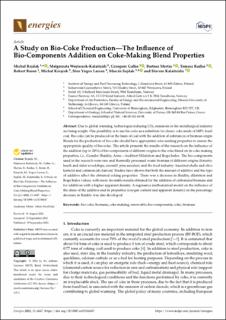| dc.contributor.author | Rejdak, Michał | |
| dc.contributor.author | Wojtaszek-Kalaitzidi, Małgorzata | |
| dc.contributor.author | Gałko, Grzegorz | |
| dc.contributor.author | Mertas, Bartosz | |
| dc.contributor.author | Radko, Tomasz | |
| dc.contributor.author | Baron, Robert | |
| dc.contributor.author | Ksiazek, Michal Tomasz | |
| dc.contributor.author | Larsen, Sten Yngve | |
| dc.contributor.author | Sajdak, Marcin | |
| dc.contributor.author | Kalaitzidis, Stavros | |
| dc.date.accessioned | 2023-01-09T09:11:18Z | |
| dc.date.available | 2023-01-09T09:11:18Z | |
| dc.date.created | 2022-11-17T08:47:57Z | |
| dc.date.issued | 2022 | |
| dc.identifier.citation | Energies. 2022, 15 (18), 1-27. | en_US |
| dc.identifier.issn | 1996-1073 | |
| dc.identifier.uri | https://hdl.handle.net/11250/3041804 | |
| dc.description.abstract | Due to global warming, technologies reducing CO2 emissions in the metallurgical industry are being sought. One possibility is to use bio-coke as a substitute for classic coke made of 100% fossil coal. Bio-coke can be produced on the basis of coal with the addition of substances of biomass origin. Blends for the production of bio-coke should have appropriate coke-making properties to ensure the appropriate quality of bio-coke. The article presents the results of the research on the influence of the addition (up to 20%) of bio-components of different origins to the coke blend on its coke-making properties, i.e., Gieseler Fluidity, Arnu—Audibert Dilatation and Roga Index. The bio-components used in the research were raw and thermally processed waste biomass of different origins (forestry: beech and alder woodchips; sawmill: pine sawdust; and the food industry: hazelnut shells and olive kernels) and commercial charcoal. Studies have shown that both the amount of additive and the type of additive affect the obtained coking properties. There was a decrease in fluidity, dilatation and Roga Index values, with more favorable results obtained for the addition of carbonized biomass and for additives with a higher apparent density. A regressive mathematical model on the influence of the share of the additive and its properties (oxygen content and apparent density) on the percentage decrease in fluidity was also developed. | en_US |
| dc.language.iso | eng | en_US |
| dc.publisher | MDPI | en_US |
| dc.rights | Navngivelse 4.0 Internasjonal | * |
| dc.rights.uri | http://creativecommons.org/licenses/by/4.0/deed.no | * |
| dc.subject | biomass | en_US |
| dc.subject | coke | en_US |
| dc.subject | bio-components | en_US |
| dc.subject | renewable | en_US |
| dc.subject | coke-making | en_US |
| dc.subject | biomass | en_US |
| dc.subject | bio-coke | en_US |
| dc.title | A Study on Bio-Coke Production—The Influence of Bio-Components Addition on Coke-Making Blend Properties | en_US |
| dc.title.alternative | A Study on Bio-Coke Production—The Influence of Bio-Components Addition on Coke-Making Blend Properties | en_US |
| dc.type | Peer reviewed | en_US |
| dc.type | Journal article | en_US |
| dc.description.version | publishedVersion | en_US |
| dc.rights.holder | Copyright: © 2022 by the authors. Licensee MDPI, Basel, Switzerland. This article is an open access article distributed under the terms and conditions of the Creative Commons Attribution (CC BY) license (https:// creativecommons.org/licenses/by/ 4.0/) | en_US |
| dc.source.pagenumber | 1-27 | en_US |
| dc.source.volume | 15 | en_US |
| dc.source.journal | Energies | en_US |
| dc.source.issue | 18 | en_US |
| dc.identifier.doi | 10.3390/en15186847 | |
| dc.identifier.cristin | 2075258 | |
| cristin.ispublished | true | |
| cristin.fulltext | original | |
| cristin.qualitycode | 1 | |

